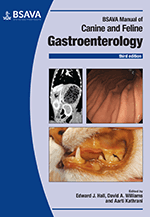
Full text loading...

Exploratory laparotomy or coeliotomy is commonly performed in order to establish or confirm a diagnosis, to determine the extent of involvement of abdominal organs by disease processes, to treat diseases and to ascertain a prognosis. This chapter covers abdominal exploration, gastrointestinal biopsy, hepatic and pancreatic biopsy, partial pancreatectomy, insulinoma and surgical treatment of pancreatitis.
Gastrointestinal surgery, Page 1 of 1
< Previous page | Next page > /docserver/preview/fulltext/10.22233/9781910443361-3e/BSAVA_Manual_Gastroenterology_3_9781910443361-3e.5.31-39-1.gif

Full text loading...










